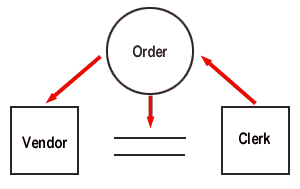This exercise is worth a total of 20 points.
You will receive up to 10 points for each correctly answered question below.
- Background and Overview
In the preceding lesson, you learned that a data flow diagram illustrates how data is handled in an organization. In this exercise, you will apply what you learned to interpret a portion of a sample data flow diagram.
- Instructions:
Examine the following graphic that shows a small section of a data flow diagram.
 Sample Data Flow diagram
Answer the following two questions:
Sample Data Flow diagram
Answer the following two questions:
- What do the parallel lines located between the Vendor and Clerk squares represent?
- How would you interpret ( in a single sentence and in the proper order), how data is being handled in the diagram?
Type or paste your answers into the text box below. Then click Submit to submit your answers and view a results page.